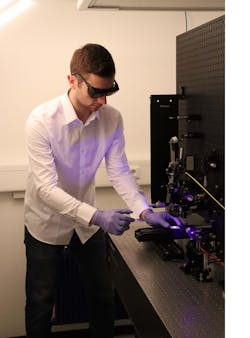Marburg University researchers detect microplastics using luminescence spectroscopy

Researchers from Marburg University (Marburg, Germany) have shown a promising alternative for the spectroscopic detection of microplastics. The pollution with microplastics is becoming an alerting environmental problem. Microplastics are commonly defined as plastic particles with diameters below 5 mm. The particles enter the environment directly as small particles from cleaning and cosmetic products or as bigger pieces of plastic litter that gradually degrade into smaller and smaller pieces. Typically, plastic particles are identified using FTIR or Raman spectroscopy.
The researchers from Marburg have shown that photoluminescence spectroscopy could be a cost-effective alternative for microplastics detection. Using a blue laser they have investigated a set of nine bulk plastic samples and nine samples of natural materials typically found in the marine environment. Although these materials are not known to be good light emitters they show photoluminescence when excited with short-wavelength light. The photoluminescence spectra look structureless and look similar at the first glance. Yet, a detailed analysis allows for a distinction between the different materials.
“Our results look promising and represent the first step towards microplastic detection using photoluminescence. Yet, a tremendous amount of work lies ahead of us if we aim for an automated technique,” says professor Martin Koch, head of the research group at Marburg University.
Details of the work are published in Applied Physics; see J. Ornik et al., Applied Physics B 126, 15 (2020).
SOURCE: Marburg University; https://www.researchgate.net/publication/338026456_Could_photoluminescence_spectroscopy_be_an_alternative_technique_for_the_detection_of_microplastics_First_experiments_using_a_405_nm_laser_for_excitation
About the Author

Gail Overton
Senior Editor (2004-2020)
Gail has more than 30 years of engineering, marketing, product management, and editorial experience in the photonics and optical communications industry. Before joining the staff at Laser Focus World in 2004, she held many product management and product marketing roles in the fiber-optics industry, most notably at Hughes (El Segundo, CA), GTE Labs (Waltham, MA), Corning (Corning, NY), Photon Kinetics (Beaverton, OR), and Newport Corporation (Irvine, CA). During her marketing career, Gail published articles in WDM Solutions and Sensors magazine and traveled internationally to conduct product and sales training. Gail received her BS degree in physics, with an emphasis in optics, from San Diego State University in San Diego, CA in May 1986.